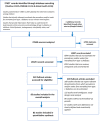Global and regional estimates of the morbidity due to type I diabetes among children aged 0-4 years: a systematic review and analysis
- PMID: 30410744
- PMCID: PMC6214490
- DOI: 10.7189/jogh.08.021101
Global and regional estimates of the morbidity due to type I diabetes among children aged 0-4 years: a systematic review and analysis
Abstract
Background: Epidemiology of type 1 diabetes mellitus (T1DM) among children aged 0-4 years globally is not well understood. We aim to assess the incidence of T1DM in low- and middle-income countries (LMIC) by conducting a systematic review of previous reports. We also aim to address possible contribution to child mortality and to identify any temporal trends.
Methods: A systematic review was performed using a carefully designed search strategy to explore MEDLINE, EMBASE and Global Health databases. Data was extracted from all studies that satisfied the inclusion criteria -a total of 83 records extracted from 26 830 sources that were analysed. We used the Grading of Recommendations Assessment, Development and Evaluation (GRADE) process to assess quality of evidence and applied meta-analysis approaches to assess global and regional incidence and time trends.
Results: The overall pooled incidence of T1DM in children aged 0-4 years globally is 11.2 (95% CI = 10.0-12.3) per 100 000 child years. The regional incidence were the highest for European Region A (EUR A) at 15.5 (95% CI = 13.5-17.5) per 100 000 child years. EUR C had the incidence of 10.0 (95% CI = 6.5-13.6) and EUR B 5.8 (95% CI = 4.7-7.0), Region of the Americas A (AMR A) 11.4 (95% CI = 7.8-14.9), AMR B of 2.5 (95% CI = 0.2-4.8), Eastern Mediterranean Region (EMR B) 7.1 (95% CI = 4.2-10.0) and Western Pacific Region (WPR A) 7.0 (95% CI = 2.9-11.0) per 100 000 child years, while other regions had very low rates or no data. When data points were categorised in the study periods and re-analysed, an increasing trend of the T1DM incidence was observed, with the incidence of 20.9 (95% CI = 7.8-34.1) per 100 000 child years in the years 2010-2015, preceded by 13.2 (95% CI = 11.0-15.5) in 2000-2009 study period, 10.0 (95% CI = 8.4-11.7) in 1990-1999 and 8.3 (95% CI = 5.1-11.6) in 1980-1989, respectively. Although the data are scarce, and variation and uncertainty are large, we estimated that the number of new cases of T1DM among children aged 0-4 years in the world each year is between 100 000 and 150 000.
Conclusions: The identified large variation in incidence estimates for different parts of the world, along with scarcity of information and the identified strong temporal increase in T1DM incidence suggest a clear need for further research into this subject.
Conflict of interest statement
Competing interest: Igor Rudan and Harry Campbell are the Co-Editors in Chief of the Journal of Global Health. To ensure that any possible conflict of interest relevant to the journal has been addressed, this article was reviewed according to best practice guidelines of international editorial organizations. The authors completed the Unified Competing Interest form at www.icmje.org/coi_disclosure.pdf (available on request from the corresponding author). The authors declare no competing interests.
Figures





References
-
- Assayed A. Diabetes in Africa: the dark tunnel. Afr Health. 2013;35:34–6.
-
- International Diabetes Federation. Diabetes Atlas, 1st ed. Brussels: International Diabetes Federation; 2000.
-
- International Diabetes Federation. Diabetes Atlas, 2nd ed. Brussels: International Diabetes Federation; 2003.
-
- International Diabetes Federation. Diabetes Atlas, 3rd ed. Brussels: International Diabetes Federation; 2006.
Publication types
MeSH terms
LinkOut - more resources
Full Text Sources
Medical
